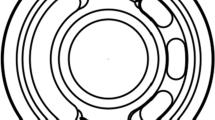The working process in a double-acting piston pump in which the valves have been replaced by fluidic diodes is investigated. A computational model of the process, constructed on the basis of a representation of a complex stream by a sum of two simple streams, the first caused by the harmonic movement of the piston and the second due to the head difference between the dampers, is proposed. Analytic expressions of the flow–head characteristics and the pump efficiency are obtained. It is shown that, unlike a piston pump with valve distribution, the flow–head characteristic of a pump with fluidic diodes is descending and flattened. In the region of low heads, its delivery may exceed the delivery of a pump with valves. There is an interval of heads on the characteristic in which the efficiency of the pump is maximal.






Similar content being viewed by others
References
T. M. Bashta, Positive-Displacement Pumps and Hydraulic Engines of Hydraulic Systems.:Textbook, Mashinostroenie, Moscow (1974).
V. E. Khabarov, Working Principle, Structural Features, and Technical Characteristics of Piston Pumps: Teach. Aid, Izd. StGAU Agrus, Stavropol (2006).
S. Takagi and T. Saijo, “Study of a piston pump without valves (1st report, on a pipe-capacity system with a T-junction),” Bull. JSME, No. 26, 1366 –1372 (1983).
E. A. Stemme and G. Stemme, “Valveless diffuser/nozzle-based fluid pump,” Sens. Actuators, No. 39, 159–167 (1993).
I. V. Lebedev, S. L. Treskunov, and V. S. Yakovenko, Elements of Fluidic Automatics, Mashinostroenie, Moscow (1973).
A. A. Kulkarni, V. V. Ranade, R. Rajeev, and S. B. Koganti, “Pressure drop across vortex diodes: Experiments and design guidelines,” Chem. Eng. Sci., 64, I.6, 1285–1292 (2009).
G. L. Yoder, Jr., Y. Elcassadgi, and G. Leon, Vortex Diode Analysis and Testing for Fluoride Salt-Colled High-Temperature Reactors, UT-Battelle (2011).
M. Anduze, S. Colin, and R. Cean, “Analysis and testing of a fluidic vortex microdiode,” J. Micromech. Microeng., No. 11, 108–112 (2011).
I. E. Idel’chik, Handbook on Hydraulic Resistance, Mashinostroenie, Moscow (1992).
P. Woias, “Micropumps – past, progress and future prospects,” Sens. Actuators, No. 105, 28–38 (2005).
T. Wada, M. Takagi, and A. Shimizu, “Study on a fluidic pump with vortex diodes,” in: Fluid Control and Measurement, Pergamon Press, Tokyo (1986), pp. 421–426.
T. A. Kletz and P. Amyotte, Process Plants: A Handbook for Inherently Safter Design, CRC Press, Taylor and Francis Group (2010), 2nd ed.
E. K. Spiridonov and D.F. Khabarova, “A computational model and characteristics of a single-acting valveless piston pump,” Vest. YuUrGU. Ser. Mashinostroenie, 14, No. 4, 13–22 (2014).
E. K. Spiridonov and K. Z. Ibragimova, “Comparison of methods of determining the diodicity of a vortex diode,” Proc. 15th Int. Sci.-Tech. Conf. of Students and Postgrad. Hydraulic Machines, Hydraulic Drives, and Pneumatic Automatic Equipment, Izd. MGTU im Baumana (2011), pp. 67–73.
Author information
Authors and Affiliations
Corresponding author
Additional information
Translated from Khimicheskoe i Neftegazovoe Mashino stroenie, No. 8, pp. 20–24, August, 2016.
Rights and permissions
About this article
Cite this article
Spiridonov, E.K., Khabarova, D.F. Computational Model and Characteristics of a Double-Acting Valveless Piston Pump. Chem Petrol Eng 52, 539–546 (2016). https://doi.org/10.1007/s10556-016-0228-z
Published:
Issue Date:
DOI: https://doi.org/10.1007/s10556-016-0228-z




